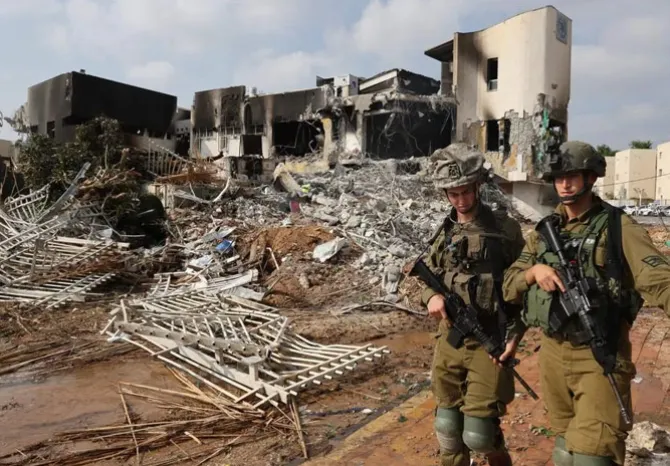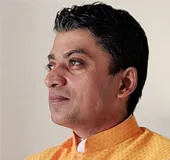
“You can sway a thousand men by appealing to their prejudices quicker than you can convince one man by logic”, says Zeb, the protagonist in Robert A Heinlein’s acclaimed 1940 science fiction novella, If This Goes On. The story, ironically set in a city called ‘New Jerusalem’, could well reflect the predicament of the Israeli government, which is struggling in the war of narratives, especially in the aftermath of the bombing of the Al-Ahli Baptist Hospital in Gaza. Despite contrary forensic conclusions, many around the world were quick to pin the blame on Israel, for what is an important turning point in this conflict. It shifted global attention away from not only the atrocities committed by Hamas and the Islamic Jihad on hapless Israeli civilians on 7 October, but also their abhorrent use of Palestinian civilians as human shields in accomplishing their military goals. The use of human shields by Hamas and Hezbollah was what led to the enactment of the 2018 “Shields Act” in the United States (US) in the first place. It requires the US president to sanction those who engage in the use of human shields.
Despite contrary forensic conclusions, many around the world were quick to pin the blame on Israel, for what is an important turning point in this conflict.
Even as the collateral damage arising from Israeli retaliation was being weaponised through distorted storytelling and amplified via sophisticated multimedia campaigns, it was the bombing of the hospital, a place of recuperation and refuge, that boosted it manifold. It served to unify an otherwise deeply divided Arab street as macabre pictures of dismembered corpses and bloodied children crowded primetime television and dominated social media trends. This inflamed public opinion against Israel, long seen as the common enemy. The visceral passions on the street, in turn, informed national responses, as wary governments deferred to mass sentiment. It is a telling example of how narratives can be manipulated to effect perverse outcomes by tapping into parochial sensibilities, captivating storytelling, and savvy use of media. The Israeli government's predicament is emblematic of the challenge faced by nation-states fighting belligerent groups, where dominating the narrative is a far greater challenge than dominating the battleground. And, when such groups exercise control over areas with sizeable civilian populations—such as Hamas in Gaza, the erstwhile The Liberation Tigers of Tamil Eelam (LTTE) in Sri Lanka, and FARC (Fuerzas Armadas Revolucionarias de Colombia) in Colombia, among many others—it becomes even more complex. These groups sway global opinion and hold disaffected populations hostage through a potent mix of propaganda, manipulation, and coercion—at once playing both victim and perpetrator. The reason for this seeming duality is twofold: Such an approach evokes potent emotional responses that rally sympathetic constituencies while intimidating adversaries and quelling internal dissent.
The visceral passions on the street, in turn, informed national responses, as wary governments deferred to mass sentiment.
Such groups are particularly adept at leveraging the power of both traditional and new media to galvanise their base and provoke international sympathy. Long before the era of hashtags, the LTTE had a dedicated media wing, producing videos of alleged army atrocities against the Tamil minority. They masterfully appealed to the Tamil diaspora, evoking feelings of kinship and generating funding and support. The FARC framed their struggle around poverty, discrimination, and class oppression, and sought legitimacy by projecting themselves as champions of the wronged. They highlighted alleged state-sponsored violence while obfuscating their criminality. Hamas has, over the years, skilfully constructed a narrative of resistance, as much to legitimise their actions as to present a contrast with their political rival, the Palestinian Authority, in a deadly battle for space and relevance. They utilise social media—the agency of discontented communities—and the might of agenda-driven state actors in this endeavour. Their narrative builds around a stark, emotional contrast—the Israeli military might and bluster versus innocent Palestinian civilians—triggering visceral responses, radicalising the street, and polarising international opinion. Such approaches, anchored in the politics of victimhood and power disparity, disadvantage the organised state. They grapple with the task of countering narratives that are emotionally potent and lean on entrenched stereotypes. However, where emotions run high and narratives define battles, time is of the essence. In the connected era, where information spreads with unparalleled velocity, biases serve as powerful anchors. Societies are fundamentally mega factories of information processing. As the quantum and complexity of information grows, they tend to incline towards familiar narratives to make meaning of their worlds. The magnification of such reduced narratives distorts reality, allowing misinformation and bias to shape opinion. For instance, almost immediately after the bombing of the Al-Ahli hospital, Hamas reported the news in all its gory detail through social media and Gaza-based news organisations while pinning the blame on Israel. By the time Israel presented evidence that implicated a rogue Islamic Jihad rocket, the story was already widespread, and the streets were afire. The Israeli position was dead on arrival, despite later expressions of regret by several news organisations for carrying unverified news. Even bewilderingly, it took Israel close to three weeks to release a video account of the events of 7 October, in a belated attempt to stem the narrative war which was going against it.
Long before the era of hashtags, the LTTE had a dedicated media wing, producing videos of alleged army atrocities against the Tamil minority.
The state’s responses are often slowed by political calculations, bureaucratic constraints, and policy loopholes. They have a further disadvantage since they are, at least in theory, bound by media ethical standards and face more rigorous scrutiny of their actions and narrations. This is especially true for democracies whose deeply contested and labyrinthine makeups inhibit swift agency. However, a significant challenge comes from the evolving dynamics of the digital realm, the new battleground for narratives. While states push back against these outfits in the digital space, their efforts at best yield mixed results as belligerents find ever-new ways to exploit the realm, making it a perennial cat-and-mouse game. The barring of Hamas from most social media platforms did not degrade its ability to harness them. Proxy handles and supporters on social media did Hamas’s bidding. Hamas' proxy 'Gaza Now' channel on Telegram, for instance, saw its followers surge by almost 400 percent to 1.3 million in under a week. Pushed to a corner, states often make the grave mistake of conflating perpetrators with their communities, often victims in their own right. This was witnessed in Sri Lanka where the Tamil population was seen as an extension of the LTTE; in Myanmar, where the Rohingya population is equated with groups like the Rohingya Solidarity Organisation and the Arakan Rohingya Salvation Army; and, in Gaza, where the campaign against Hamas has disproportionately impacted civilians. It holds true in almost every conflict. Unfortunately, such faulty transposing of ideas, ideals, and ideologies makes entire communities fair targets for violent state-sponsored reprisals. This ironically transforms victims into perpetrators and creates a situation of compounded injustice for civilians caught in the crossfire. It leads to a cycle of unending violence, which often only ceases when one party to the conflict brings to bear enormous and disproportionate force, obliterating the adversarial other—as witnessed in Sri Lanka and as Israel has now threatened to do.
Societies are fundamentally mega factories of information processing. As the quantum and complexity of information grows, they tend to incline towards familiar narratives to make meaning of their worlds.
Conflicts are as much about the battle for hearts and minds as they are about the clash of arms. Propaganda and parochialism act as lightning rods, coalescing opinions, shaping agency, and directing the course of conflicts. Belligerent groups operate with an upper hand. They are unencumbered by the weight of accountability and skilfully invoke sympathy by portraying victimhood. In contrast, organised states bear the heavy mantle, their very might and organisation paradoxically becoming their Achilles' heel in this asymmetrical warfare of perception. At a time when information spreads faster than thought and opinions precipitate around prejudices more insolubly than any chemical metathesis, states grapple with countering divisive narratives. In an information-dense landscape where narratives inform one’s sense of right and wrong and place in the world, states need to transition from reticence and reactive defence to agile and proactive engagement. They need to evolve from reporting facts and retorting fabrications to compelling and timely storytelling. Beyond being mere communicators, they need to become conscientious narrators of their own unfolding histories. The US response to the Al-Firdos bunker bombing incident in downtown Baghdad during Operation Desert Storm in 1991 may offer a template. Over 400 civilians were killed in the attack on the facility. The then-Iraqi regime sought to quickly capitalise, taking international media crews to the site. However, the US military’s rationalisation within hours helped balance the narrative. The incident understandably sparked outrage in the region and has remained controversial.
At a time when information spreads faster than thought and opinions precipitate around prejudices more insolubly than any chemical metathesis, states grapple with countering divisive narratives.
The Al-Ahli Hospital bombing and its aftermath underscore the inherent challenge that states face when pitted against underdog ideologies anchored in the politics of victimhood. The perennial handicap for the state is that it is always seen as the oppressive Goliath to the vulnerable Davids, which has powerful emotive appeal. In his 2011 book, The Better Angels of Our Nature, Steven Pinker writes, “An ideology can provide a satisfying narrative that explains chaotic events and collective misfortunes in a way that flatters the virtue and competence of believers, while being vague or conspiratorial enough to withstand sceptical scrutiny.” There is no silver bullet to navigate this perception conundrum. In a landscape where the algorithm is the anthem, and narratives nudge notions, speed and substance are the only steady anchors a state truly has.
Jaibal Naduvath is Vice President and Senior Fellow of the Observer Research Foundation
The views expressed above belong to the author(s). ORF research and analyses now available on Telegram! Click here to access our curated content — blogs, longforms and interviews.




 PREV
PREV


